One of the most powerful ideas in higher education today is transforming campuses into learning communities. At last, Shapiro and Levine have given us--faculty, students, and administrators--a handbook on how to accomplish this. It is one of those too rare and much-needed volumes on translating theory into practice by authors who have actually done it.
--Arthur Levine, president, Teachers College, Columbia University
Shapiro and Levine convince us that learning communities address what we now know about how students learn inside and outside the classroom. Read this book for conceptual rationale, practical answers to implementation questions, and passionate voices that speak for a social contract among students, faculty members, and institutions, a contract enacted and assessed for the benefit of all.
--Barbara L. Cambridge, director, Teaching Initiatives, American Association for Higher Education
In recent years, learning communities--a curricular innovation that integrates different facets of the undergraduate experience to enhance and enrich learning--have become the most promising new strategy for promoting student success and satisfaction in college. Now campus professionals have a practical, insightful guide to the essentials of this timely and rewarding new program area, including how to design, fund, staff, manage, and integrate learning communities into different campuses. Drawing from their own experience as well as from experiences of campuses around the country, Nancy S. Shapiro and Jodi H. Levine present a pragmatic blueprint for creating a learning community that can be adapted to almost any campus culture--including specific guidance ranging from who should be placed on planning committees to samples of syllabi for interdisciplinary courses, sample clusters of classes, monthly activity calendars, lists of competencies and expected student outcomes, and other operational program models.







